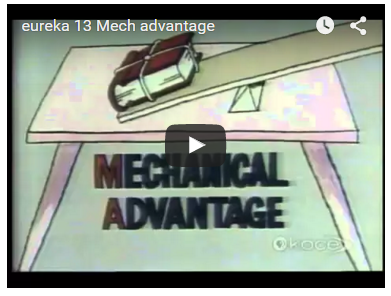Overview
Mechanical advantage is measure of how much effort it to do something without a device, such as lifting a hay bale, divided by how much it takes to do that with the aid of a device, such as lifiting a bale of hay with a pulley system. Mechanical advantage tells us how much easier a job is with a tool than without.
Specific Learning Objectives
- Identify when a system provides mechanical advantage.
- Be able to identify why that system provides mechanical advantage.
- Calculate mechanical advantage based on a free body diagram.
- Be able to design a system that provides MA.
- Know how to calculate the total MA of coupled systems, each contributing MA to the total.
Key Terms
Concept Map
Fundamentals
Introduction
Mechanical advantage (MA) is the ratio of the force neede to do a task without any aid, to the force needed to do a task with aid. Common tools that give mechanical advantage are ramps, pulleys, and levers. The most common way of calculating mechanical advantage is to determine the amount of force it takes to do a task unaided, by drawing a free body diagram, and then calculating how much force it takes to do the same task, again, by drawing a free body diagram and carefully summing your forces. A common mistake people make is with pulleys. The number of pulleys is not necessarily equal to the mechanical advantage.
Content
Text/Videos
Here is a physics site for non-physics people that has a very good explination of mechanical advantage;
For more information on mechanical advantange check out;
It has a through discusion on what is mechanical advantage, what systems produce it, and how to calculate it. Warning: We will not be covering any rotation in PH201. Also, there is a small discusion on work. As we have not covered this yet feel free to ignore it.
Also, check out some the important features of mechanical advantage, and try out some example problems.
Simulations
Pulley system with lots of variables that can be changed and measured.
Another pulley system with less functionality
Additional Studying/Review
Below are a few extra websites. Please feel free to check them out if you still have questions on mechanical advantage.
-
A simple site that looks at mechanical advantage. This site is a good supplemental too, but it does not cover the topic very well, and there is little mention of mechanical advantage itself.
-
Here is an old cartoon discussing Mechanical Advantage(we will not be doing any levers this term);
-
And for the Bill Nye fans this is a video of Bill Nye discussing mechanical advantage:
Common Mistakes and Misconceptions
A very common misconception is that the number of pulleys in a system is equal to the mechanical advantage of the system. This is not necessarily true. You must always carefully draw a FBD for every system.
Fundamental Example
- Placeholder
- Placeholder
Nuts & Bolts
Algorithm
-
Identify all of the forces acting on a system.
-
Calculate the force required to do a task, such as lift an object.
-
Calculate how much force it would take to do the above task with the aid of the system
-
Divide the force required without aid by the force required with aid.
| Multiple Representations is the idea that a physical phenomena can be explored in many different ways. For example, there is the physical representation which models the system with figures and diagrams, such as a free body diagram. There is also the mathematical representation which uses the equation(s) governing the physics of the system. All of the representations can be used together to help us understand and quantify the physical phenomena. |
Observe the different types of representations for this section below;

This site has great step by step caluclations for MA.

A graph of three ramps at different angles plotting the force required to lift an object, unaided, vs lifting the object with the ramp.
I am trying to life a box that weighs 600 N. I can only lift 150 N as I don’t even lift bro. However, the physics is strong with me and I know that I can use a pulley system like the one in the physical representation section above.
This video is good example of Mechanical Advantage;
Also this video shows a man using MA to pull his truck;
Tips & Tricks
Misconceptions & Common Mistakes
Protips
Learning Tools
Activities
Content
Demos
Example Problems
Labs
Recitation
Simulation
Student contributed content
Old Content Below
-
Specific learning objectives/goals Motivation/guidance for objectives… what we want students to walk away with
-
Content: traditional textbook, “online textbook”, or traditional lecture content
-
TLDR version
-
Equation list broken into fundamental and applied
-
-
Verbose, textbook style version
-
-
Concept Map, connections
-
Algorithm/recipe/checklist/procedure: Not all topics will have cut and dry lists
-
Tools - all the things you use to analyze these problems
-
When it breaks down
-
-
-
Physical: annotated cartoon
-
Mathematical
-
Mathematization
-
-
Graphical
-
Descriptive: words
-
Actual phenomena: experiment, video
-
-
-
-
How to address misconception
-
-
-
Language/ESL
-
Reserved words, e.g. heat
-
-
-
-
Types: where you drop in, i.e. given a video, given text, given diagram
-
Conceptual
-
Quantitative
-
Discipline specific
-
-
Engagement Activities
-
-
Clicker type shorter conceptual/quantitative
-
Longer worksheet type activities
-
Kinesthetic exercises
-
-
Out of class: Applets or programs
-
At home virtual lab
-
At home “real” lab activities
-
-
Lab
-
Recitation
-
Passive: students just watch
-
Interactive: students engage in the event
-
-
Random relevant web videos: kitten shot from a cannon
-
-
Content descriptions: ways they thought of it that helped understand
-
Example problems
-
